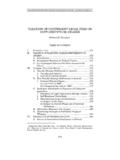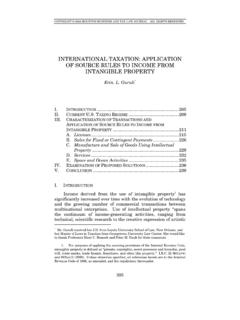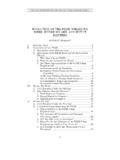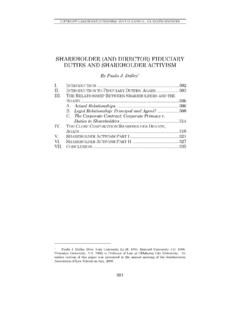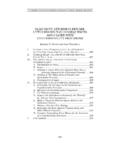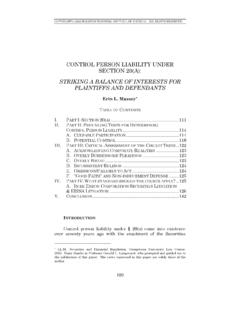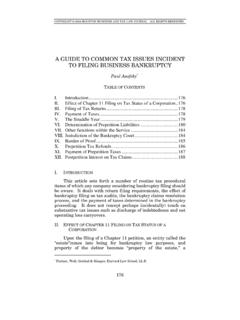Transcription of A PRACTITIONER’S GUIDE TO JOINT EMPLOYER …
1 COPYRIGHT 2002 HOUSTON BUSINESS AND TAX LAW JOURNAL. ALL RIGHTS RESERVED. 393 A practitioner S GUIDE TO JOINT EMPLOYER LIABILITY UNDER THE flsa Richard J. Burch* TABLE OF CONTENTS I. II. BACKGROUND FOR THE DEVELOPMENT OF THE flsa ..395 A. Working Conditions in the B. President Roosevelt s Proposal for III. OVERVIEW AND PURPOSE OF THE IV. SECURING THE BENEFITS OF THE A. The Expansive Nature of the Employment B. The Broader Reach of the flsa As Compared to Other Remedial C. Effect of Contractual V. JOINT EMPLOYER A. The Importance of the JOINT EMPLOYER B. The Economic Reality C. Factors Used to Determine Economic D. Using the Interpretative Guidelines to Help Determine the Relevant Factors ..411 1. Agreement Between Employers to Share Employee Services ..411 2. Employers Acting Directly or Indirectly in the Interest of Another 3. Employers who are not Completely Disassociated Sharing Direct or Indirect Control of VI.
2 * Partner, Bruckner Burch, , Houston, Texas; University of Houston Law Center, , 1997. COPYRIGHT 2002 HOUSTON BUSINESS AND TAX LAW JOURNAL. ALL RIGHTS RESERVED. 394 HOUSTON BUSINESS AND TAX LAW JOURNAL [Vol. II I. INTRODUCTION In 1938, Congress passed what can be described as the most ambitious and progressive piece of social welfare legislation ever implemented,1 the Fair Labor Standards Act ( flsa ).2 The flsa of 1938 was Congress first effort to establish minimum labor Designed both to protect workers and to force employers to be reputable,4 the flsa is impressive in its breadth. To ensure broad application of its protections, the flsa extends liability for non-compliance with its terms beyond the bounds of ordinary The purpose of this comment is to provide a quick reference to materials pertinent to the issue of the JOINT EMPLOYER doctrine within the flsa .]
3 Part II describes the historical background for the development of the flsa . Part III gives an overview of the flsa and explains the purpose behind its enactment. Part IV discusses the expansive scope of the flsa . Part V evaluates the flsa s expansive definition of employment as specifically related to the JOINT EMPLOYER doctrine. Part VI concludes with a brief summary of the issues touched upon by this comment. 1. See Bruce Goldstein et al., Enforcing Fair Labor Standards in the Modern American Sweatshop: Rediscovering the Statutory Definition of Employment, 46 UCLA L. REV. 983, 1004 05 (1999) (explaining that: When enacted in 1938, the flsa included interlocking definitions that Congress designed to bring within their sweep an incomparably broader spectrum of working people and employment settings than the common law or even many labor-protective statutes had ever covered).
4 2. Pub. L. No. 75-718, 52 Stat. 1060 69 (codified as amended at 29 201 et seq. (2000)). 3. See Philip L. Bartlett II, Disparate Treatment: How Income Can Affect the Level of EMPLOYER Compliance with Employment Statutes, 5 J. LEGIS. & PUB. POL Y 419, 472 (2002) (providing a brief summary of the three primary purposes behind the flsa in discussing how the expected cost of violating the statute is likely to vary with income). 4. See Brooklyn Sav. Bank v. O Neil, 324 697, 706 07 (1945) (stating that: The legislative history of the [ flsa ] shows an intent on the part of Congress to protect certain groups of the population from substandard wages and excessive hours which endangered the national health and well-being and the free flow of goods in interstate commerce. The statute was a recognition of the fact that due to the unequal bargaining power as between EMPLOYER and employee, certain segments of the population required federal compulsory legislation to prevent private contracts on their part which endangered national health and efficiency and as a result the free movement of goods in interstate commerce).
5 5. See Goldstein et al., supra note 1, at 1004 (explaining that [t]he reach of coverage went beyond employers to include any business owners suffering or permitting others to work, and that [t]he striking breadth of the flsa definition of employ covers work relationships that were not within the EMPLOYER -employee category at common law ). COPYRIGHT 2002 HOUSTON BUSINESS AND TAX LAW JOURNAL. ALL RIGHTS RESERVED. 2002] JOINT EMPLOYER LIABILITY 395 II. BACKGROUND FOR THE DEVELOPMENT OF THE flsa A. Working Conditions in the 1930s To understand the striking breadth of the flsa s impact on employment relationships,6 it is helpful to understand the working conditions that brought about its passage. In the mid to late 1930 s, America was still in the clutches of the Great Depression. At times, more than 25% of the country s available workforce was Those fortunate enough to have a job at all often worked in deplorable In addition to the problem of child labor, long hours and substandard wages were common for many It was against this background that President Franklin D.
6 Roosevelt submitted his proposal for change. B. President Roosevelt s Proposal for Change In a message to Congress, President Roosevelt stated: [o]ur nation so richly endowed with natural resources and with a capable and industrious population should be able to devise ways and means of insuring to all our able-bodied working men and 6. See id. 7. See Patricia E. Dilley, Taking Public Rights Private: The Rhetoric and Reality of Social Security Privatization, 41 REV. 975, 1029 (2000) (quoting the Introduction to THE DEFINING MOMENT: THE GREAT DEPRESSION AND THE AMERICAN ECONOMY IN THE TWENTIETH CENTURY (Michael D. Bordo et al. Eds., 1998)). As Professor Dilley noted: In terms of its impact on economic performance, the depression was a disaster without equal in the twentieth century. The contraction phase of the depression, extending from August 1929 to March 1933, saw the most severe decline in key economic aggregates in the annals of business cycle history.
7 Real GNP fell by more than one-third, as did the price level. Industrial production declined by more than 50%. Unemployment rose to 25 percent by 1933. Id.; see also Lucy A. Williams & Margaret Woo, Doing Business in China and Latin America: Developments in Comparative and International Labor Law: The Worthy Unemployed: Societal Stratification and Unemployment Insurance Programs in China and the United States, 33 COLUM. J. TRANSNAT L L. 457, 494 n. 192 (1995). 8. See WATKINS, THE GREAT DEPRESSION: AMERICA IN THE 1930S 167 (Blackside, Inc. 1993) (noting that [e]ven in the best of times, wages had never managed to rise proportionately to the cost of living, hours remained long and hard, working conditions were typically abysmal, and in many industries factory work was only a little above the level of peonage ). 9. See id.; Monohan v. County of Chesterfield, 95 1263, 1267 (4th Cir.)
8 1996) (explaining that [t]he flsa was originally enacted in 1938 as the result of Depression era high unemployment and abusive working conditions, and that [t]he flsa is clearly structured to provide workers with specific minimum protections against excessive work hours and substandard wages ). COPYRIGHT 2002 HOUSTON BUSINESS AND TAX LAW JOURNAL. ALL RIGHTS RESERVED. 396 HOUSTON BUSINESS AND TAX LAW JOURNAL [Vol. II women a fair day s pay for a fair day s work. 10 President Roosevelt went on to decry various existing labor practices, such as the use of child labor, the chiseling of workers wages, and extended working Shortly thereafter, Congress held a number of proceedings and debates which focused on the effect of substandard labor conditions in the One reason the Congressional committee offered in support of the press for federal legislation was that in the absence of such legislation goods produced under substandard labor conditions in one state may, if protected by the failure of Congress to exercise its commerce power, flow freely into another state that attempts to maintain its fair labor standards.]
9 13 Thus, with the support of the President and of the largely democratic Congress, the Fair Labor Standards Act was III. OVERVIEW AND PURPOSE OF THE flsa The flsa establishes a minimum wage, overtime pay, record keeping, and child labor standards affecting full-time and part-time workers in the private sector and in federal, state, and local The policies behind the flsa are expressed within the For example, Congress sought to eliminate 10. REP. NO. 101-260, at 8 9 (1989), reprinted in 1989 696, 696 97. 11. See id. at 9, reprinted in 1989 at 697. 12. See, , 81 CONG. REC. 7652, 7672, 7885; 82 CONG. REC. 1386, 1395, 1491, 1505, 1507; 83 CONG. REC. 7283, 7298, 9260, 9265. 13. REP. NO. 75-2182, at 6 (1938). 14. See REP. NO. 101-260, at 9 10 (1989), reprinted in 1989 690, 697 98. 15. See 29 206, 207, 211(c), 212 (2000); see also Bartlett, supra note 3, at 472 73 (summarizing the three primary purposes of the flsa as: (1) establishing a minimum wage, which is currently $ per hour, and prohibiting wage differentials based on gender; (2) requiring premium pay for overtime work equal to one and one-half times the regular wage rate; and (3) restricting the ability of firms to employ children).
10 16. See id. 202. Section 202 prescribes that: (a) The Congress hereby finds that the existence, in industries engaged in commerce or in the production of goods for commerce, of labor conditions detrimental to the maintenance of the minimum standard of living necessary for health, efficiency, and general well-being of workers (1) causes commerce and the channels and instrumentalities of commerce to be used to spread and perpetuate such labor conditions among the workers of the several States; (2) burdens commerce and the free flow of goods in commerce; (3) constitutes an unfair method of competition in commerce; (4) leads to labor disputes burdening and obstructing commerce and the free flow of goods in commerce; and (5) interferes with the orderly and fair marketing of goods in commerce. That Congress further finds that the employment of persons in domestic service in households affects commerce.

